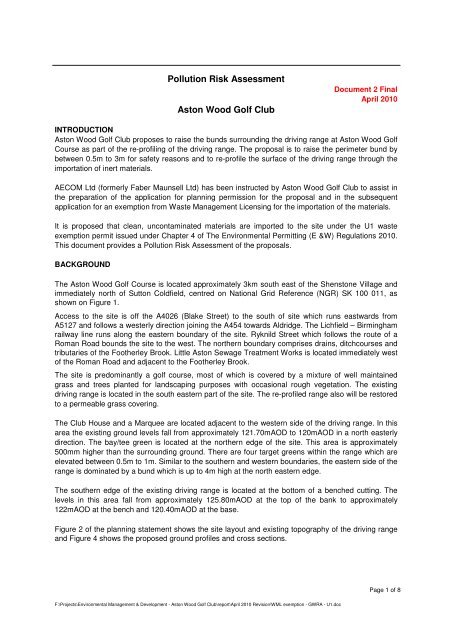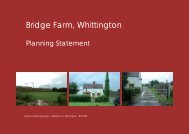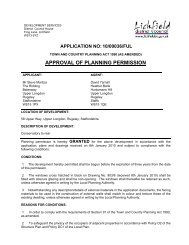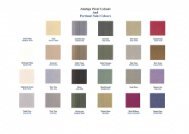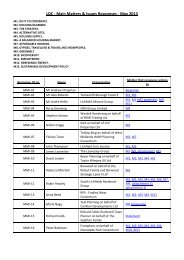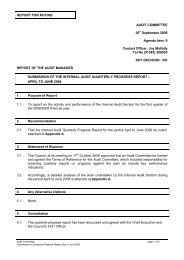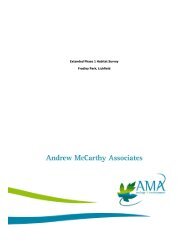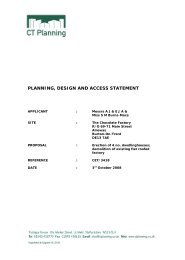Pollution Risk Assessment Aston Wood Golf Club
Pollution Risk Assessment Aston Wood Golf Club
Pollution Risk Assessment Aston Wood Golf Club
Create successful ePaper yourself
Turn your PDF publications into a flip-book with our unique Google optimized e-Paper software.
<strong>Pollution</strong> <strong>Risk</strong> <strong>Assessment</strong><br />
<strong>Aston</strong> <strong>Wood</strong> <strong>Golf</strong> <strong>Club</strong><br />
Document 2 Final<br />
April 2010<br />
INTRODUCTION<br />
<strong>Aston</strong> <strong>Wood</strong> <strong>Golf</strong> <strong>Club</strong> proposes to raise the bunds surrounding the driving range at <strong>Aston</strong> <strong>Wood</strong> <strong>Golf</strong><br />
Course as part of the re-profiling of the driving range. The proposal is to raise the perimeter bund by<br />
between 0.5m to 3m for safety reasons and to re-profile the surface of the driving range through the<br />
importation of inert materials.<br />
AECOM Ltd (formerly Faber Maunsell Ltd) has been instructed by <strong>Aston</strong> <strong>Wood</strong> <strong>Golf</strong> <strong>Club</strong> to assist in<br />
the preparation of the application for planning permission for the proposal and in the subsequent<br />
application for an exemption from Waste Management Licensing for the importation of the materials.<br />
It is proposed that clean, uncontaminated materials are imported to the site under the U1 waste<br />
exemption permit issued under Chapter 4 of The Environmental Permitting (E &W) Regulations 2010.<br />
This document provides a <strong>Pollution</strong> <strong>Risk</strong> <strong>Assessment</strong> of the proposals.<br />
BACKGROUND<br />
The <strong>Aston</strong> <strong>Wood</strong> <strong>Golf</strong> Course is located approximately 3km south east of the Shenstone Village and<br />
immediately north of Sutton Coldfield, centred on National Grid Reference (NGR) SK 100 011, as<br />
shown on Figure 1.<br />
Access to the site is off the A4026 (Blake Street) to the south of site which runs eastwards from<br />
A5127 and follows a westerly direction joining the A454 towards Aldridge. The Lichfield – Birmingham<br />
railway line runs along the eastern boundary of the site. Ryknild Street which follows the route of a<br />
Roman Road bounds the site to the west. The northern boundary comprises drains, ditchcourses and<br />
tributaries of the Footherley Brook. Little <strong>Aston</strong> Sewage Treatment Works is located immediately west<br />
of the Roman Road and adjacent to the Footherley Brook.<br />
The site is predominantly a golf course, most of which is covered by a mixture of well maintained<br />
grass and trees planted for landscaping purposes with occasional rough vegetation. The existing<br />
driving range is located in the south eastern part of the site. The re-profiled range also will be restored<br />
to a permeable grass covering.<br />
The <strong>Club</strong> House and a Marquee are located adjacent to the western side of the driving range. In this<br />
area the existing ground levels fall from approximately 121.70mAOD to 120mAOD in a north easterly<br />
direction. The bay/tee green is located at the northern edge of the site. This area is approximately<br />
500mm higher than the surrounding ground. There are four target greens within the range which are<br />
elevated between 0.5m to 1m. Similar to the southern and western boundaries, the eastern side of the<br />
range is dominated by a bund which is up to 4m high at the north eastern edge.<br />
The southern edge of the existing driving range is located at the bottom of a benched cutting. The<br />
levels in this area fall from approximately 125.80mAOD at the top of the bank to approximately<br />
122mAOD at the bench and 120.40mAOD at the base.<br />
Figure 2 of the planning statement shows the site layout and existing topography of the driving range<br />
and Figure 4 shows the proposed ground profiles and cross sections.<br />
Page 1 of 8<br />
F:\Projects\Environmental Management & Development - <strong>Aston</strong> <strong>Wood</strong> <strong>Golf</strong> <strong>Club</strong>\report\April 2010 Revision\WML exemption - GWRA - U1.doc
GEOLOGY<br />
The geology of the area is interpreted from the British Geological Survey (BGS) 1:10,000, scale map<br />
SK00SE (Lichfield) and the BGS 1:50,000 scale map, Sheet 154, Lichfield. The golf course is<br />
underlain by strata of Carboniferous and Permo-Triassic age. Sandstones and mudstones of the<br />
Bowhills Formation crop out in a faulted block, which forms a band running north west to south east<br />
across the golf course. To the east are sandstones of the Sherwood Sandstone Formation,<br />
represented by the Wildmoor Sandstone. To the west, the Kidderminster Formation, also part of the<br />
Sherwood Sandstone, crops out. The solid strata are covered by a variable thickness of superficial<br />
deposits of boulder clay, peat and river terrace sands and gravels. The superficial deposits obscure<br />
the junction between the Bowhills Formation and the Wildmoor Formation to the east. It is inferred<br />
that the majority of the application site is underlain by the Bowhills Formation.<br />
HYDROGEOLOGY<br />
The granular layers in the superficial deposits have a variable but generally moderate intergranular<br />
permeability which facilitates groundwater movement. The glacial boulder clay, which typically is clayrich,<br />
has a low intergranular permeability which restricts groundwater movement.<br />
It is likely that the sandstone units of the Bowhills Formation have a moderate intergranular<br />
permeability, which facilitates the movement of groundwater. Mudstone bands within the Bowhills<br />
Formation have a low permeability, which restricts vertical groundwater movement and supports a<br />
series of individual water-bearing units in the overlying sandstone bands. There are a number of small<br />
former marl pits in the area, which are associated with mudstone horizons in the Bowhills Formation.<br />
The sandstones and conglomerates of the Sherwood Sandstone typically have a high permeability<br />
which facilitates significant groundwater movement.<br />
The Bowhills Formation is designated as a secondary aquifer by the Environment Agency (EA). The<br />
Sherwood Sandstone is designated as a principal aquifer. The Sherwood Sandstone is a regionally<br />
important aquifer, which has been exploited for public and private water supplies. The glacial deposits<br />
are classified as secondary aquifers in the Environment Agency’s ‘Policy and Practice for the<br />
Protection of Groundwater’ (Groundwater Vulnerability Map Sheet 22, Scale 1:100,000).<br />
Groundwater in these units may be important for local groundwater supplies and for providing<br />
baseflow to rivers.<br />
The Environment Agency’s website indicates that part of the site lies within the total catchment area<br />
of the Groundwater Source Protection Zone (SPZ) for a groundwater abstraction well for public water<br />
supply located approximately 3km north east of the site. However, most of the driving range area is<br />
outside this total catchment area except for the eastern part which falls within the outer zone. The<br />
website indicates that there are no licensed groundwater abstractions within 2km of the site. There is<br />
no information on the groundwater level beneath the site. However, due to the presence of many<br />
ponds on the course and an extensive surface water drainage system, it is likely that in both the<br />
Bowhills Formation and the Sherwood Sandstone, water levels are shallow and that the direction of<br />
groundwater flow is controlled by the local surface water drainage system, the Footherly Brook, which<br />
flows to the north. It is considered that groundwater in both strata provides baseflow to the surface<br />
water system and that beneath the site area, groundwater flow is northerly or north easterly. Figure 3<br />
shows the Groundwater Source Protection Zone in the vicinity of the site.<br />
HYDROLOGY<br />
The Footherley Brook enters the golf course at the south eastern corner and flows in a generally north<br />
– north westerly direction approximately 110m east of the driving range. A second arm of the brook<br />
flows in a northerly direction to the west of the golf course. The two tributaries of the Footherley Brook<br />
join approximately 700m north west of the site from where the Footherley Brook flows in a north<br />
easterly direction towards Shenstone Village.<br />
Page 2 of 8<br />
F:\Projects\Environmental Management & Development - <strong>Aston</strong> <strong>Wood</strong> <strong>Golf</strong> <strong>Club</strong>\report\April 2010 Revision\WML exemption - GWRA - U1.doc
The quality of the Footherley Brook obtained from the EA website was classified in 2007 as chemical<br />
quality assessment grade C (fairly good) for the 3.7km stretch north of the golf course, from Little<br />
<strong>Aston</strong> STW (NGR 409350 301900) to Black Bourne Brook (NGR 410750 305050).<br />
Several ponds and drains are present across the golf course. The existing driving range is drained via<br />
a ditchcourse which flows from the north eastern corner to a small ditch which discharges into the<br />
eastern arm of the Footherley Brook on the eastern edge of the site.<br />
WASTE INPUTS<br />
It is proposed to re-profile the driving range at <strong>Aston</strong> <strong>Wood</strong> <strong>Golf</strong> course using uncontaminated inert<br />
waste materials. An application for an exemption from Waste Management Licensing under the U1<br />
waste exemption permit under Chapter 4 of The Environmental Permitting (E &W) Regulations 2010<br />
will be submitted to the Environment Agency following granting of planning permission.<br />
The proposed waste types to be used are presented in Table 1. It is estimated that up to 43,000m 3 of<br />
materials are required to achieve the proposed re-profiled site.<br />
It is envisaged that the restoration materials imported to the site will originate from a small number of<br />
sources. At this stage, it is not possible to confirm the sources.<br />
Table 1 Waste types proposed for use at the <strong>Aston</strong> <strong>Wood</strong> <strong>Golf</strong> <strong>Club</strong><br />
Source of waste Kind of waste EWC Code<br />
Waste from physical and<br />
chemical processing of nonmetalliferous<br />
minerals<br />
Wastes from the manufacture<br />
of ceramic goods, bricks, tiles<br />
and construction pieces<br />
Waste gravel and crushed<br />
rocks other than those<br />
containing dangerous<br />
substances<br />
Waste sand and clays<br />
Waste ceramics, bricks, tiles<br />
and construction products<br />
(after thermal processing).<br />
01 04 08<br />
01 04 09<br />
10 12 08<br />
Concrete, bricks, tiles and<br />
ceramics<br />
Wastes from the mechanical<br />
treatment of waste (for<br />
example sorting, crushing,<br />
compacting, pelletising) not<br />
otherwise specified<br />
Concrete<br />
Bricks<br />
Tiles and ceramics<br />
Mixtures of concrete, bricks,<br />
tiles and ceramics<br />
Minerals (for example sand,<br />
stones)<br />
17 01 01<br />
17 01 02<br />
17 01 03<br />
17 01 07<br />
19 12 09<br />
Contaminated soils will not be considered for importation and use on the site to minimise any risk to<br />
human health and, in particular, to minimise any risk to the underlying groundwater and to surface<br />
water quality. All materials imported for restoration will contain potential contaminants in<br />
concentrations below the threshold levels detailed in Table 2.<br />
Page 3 of 8<br />
F:\Projects\Environmental Management & Development - <strong>Aston</strong> <strong>Wood</strong> <strong>Golf</strong> <strong>Club</strong>\report\April 2010 Revision\WML exemption - GWRA - U1.doc
All materials imported to the site for restoration will be inspected visually prior to disposal onto the<br />
site. Any materials which are considered unacceptable due to the presence of visual and/or odiferous<br />
substances will not be allowed to unload and will be turned away from the site.<br />
POLLUTION RISK ASSESSMENT<br />
To facilitate re-profiling of the driving range at <strong>Aston</strong> <strong>Wood</strong> <strong>Club</strong>, it is proposed that inert materials are<br />
imported to the site in order to raise the perimeter bund for safety reasons and to reduce water<br />
logging of the existing facility. Clean, inert soils and natural deposits, excavated from uncontaminated<br />
sites, will be used to achieve the proposed restoration profile. It is estimated that the required volume<br />
of imported materials is approximately 43,000m 3 .<br />
The imported materials will be deposited directly as they are brought onto site. If suitable topsoil or<br />
soil forming materials are delivered to the site, these may be stored in temporary stockpiles subject to<br />
the requirements on the site at the time of delivery.<br />
To assess the potential environmental impacts associated with the importation of the waste materials,<br />
a qualitative risk assessment has been undertaken using the source-pathway-receptor approach<br />
promoted by DEFRA and the Environment Agency. For there to be an identifiable risk, not only must<br />
there be contaminants present on the site (source) ie contaminated ground or groundwater but also<br />
there must be a receptor and a pathway, which allows the source to reach the receptor. All three<br />
elements must be present to form a pollutant linkage before there can be a potential risk to specific<br />
receptors.<br />
In accordance with standard practice, a conceptual model of the potential or actual pollutant linkages<br />
was developed for the site, to evaluate the likely impacts of the importation of any contaminated<br />
materials on human health and controlled waters.<br />
Based on a review of the ground and groundwater conditions at the site, the potential sources of<br />
contamination associated with the proposal, the receptors and contaminant migration pathways have<br />
been identified.<br />
The principal sources of contamination identified on the site are:-<br />
• Contaminants present within the materials imported to the site.<br />
• Soluble contaminants present within the materials imported to the site.<br />
The principal receptors are:-<br />
• Site operatives<br />
• Site end users<br />
• Groundwater in the underlying fluvio-glacial deposits and the Sherwood Sandstone; and,<br />
• Surface waters, in particular ponds on the golf course and the Footherley Brook.<br />
The main pathways for the identified contaminant sources to impact on the receptors are:-<br />
• Dermal contact and oral intake of contaminants through direct contact with contaminated<br />
materials and the inhalation of dust and vapours;<br />
• Leaching of soluble contaminants by infiltration of incident rainfall and movement to the<br />
underlying groundwater;<br />
• Surface water runoff of contaminants to the site drainage system and thence to the<br />
Footherley Brook; and,<br />
• Migration of contaminated groundwater and site drainage to the surface water system and<br />
thence to the Footherley Brook.<br />
Page 4 of 8<br />
F:\Projects\Environmental Management & Development - <strong>Aston</strong> <strong>Wood</strong> <strong>Golf</strong> <strong>Club</strong>\report\April 2010 Revision\WML exemption - GWRA - U1.doc
Impact on human health<br />
The imported materials will comprise inert materials excavated from uncontaminated development<br />
sites. Contaminated soils will not be considered for importation and use on the site. All materials<br />
imported for restoration will contain potential contaminants in concentrations below the threshold<br />
levels detailed in Table 2.<br />
All materials imported to the site for restoration will be inspected visually prior to disposal onto the<br />
site. Any materials which are considered unacceptable due to the presence of visual and/or odiferous<br />
substances will not be allowed to unload and will be turned away from the site. A record will be kept<br />
of all materials delivered to the site and of any loads refused permission to unload on the site.<br />
Table 2: Maximum threshold concentrations of contaminants in waste soils imported to the<br />
site<br />
Contaminant Threshold<br />
concentration<br />
(mg/kg)<br />
Contaminant Threshold<br />
concentration<br />
(mg/kg)<br />
pH range 6 to 9 (pH units) Selenium 260<br />
Arsenic 20 Zinc 300<br />
Cadmium 30 Boron 3<br />
Chromium 200 Free cyanide 25<br />
Copper 200 Complex cyanide 250<br />
Lead 450 PAH(16) 50<br />
Mercury 15 Phenols 80<br />
Nickel 75 Total petroleum<br />
hydrocarbons<br />
500<br />
The proposed threshold concentrations are a combination of the previously published Soil Guidance<br />
Values (SGVs) for a residential end use without plant uptake, MAFF (Ministry of Agriculture Fisheries<br />
and Food) Soil Guidance Values, the Dutch Intervention Levels and in-house generic screening<br />
values for hydrocarbons. Although the SGVs have been withdrawn, it is considered that these criteria<br />
will provide stringent levels that will provide long term environmental protection.<br />
As it is proposed that all materials imported for the re-profiling will have to meet the screening criteria<br />
given in Table 2 above, the risk to human health is considered to be low. Additionally, any materials<br />
which are considered unacceptable due to the presence of visual and/or odiferous substances will not<br />
be allowed to unload and will be turned away from the site.<br />
The site operatives will not be exposed to any risk of coming into direct contact with contaminated<br />
material as no contaminated materials will be imported to the site. However, as a precautionary<br />
measure, appropriate PPE should be worn at all times during the works in order to minimise the<br />
potential risks of any unforeseen risks on the site workers. The potential risk of impact on site end<br />
users also is considered to be low as no contaminated material will imported to the site.<br />
In summary, it is concluded that the importation of uncontaminated, naturally-occurring inert materials<br />
would not pose a significant adverse risk to human health.<br />
Impact on controlled waters<br />
Page 5 of 8<br />
F:\Projects\Environmental Management & Development - <strong>Aston</strong> <strong>Wood</strong> <strong>Golf</strong> <strong>Club</strong>\report\April 2010 Revision\WML exemption - GWRA - U1.doc
The site is located in a sensitive location in respect of both groundwater and surface waters. The<br />
underlying Triassic Sherwood Sandstone is an important aquifer which is used in the area as a source<br />
of both public and private water supplies. However, there is no known licensed abstraction within 2km<br />
of the site but there may be small private abstractions which are currently unknown. Part of the site<br />
lies within the total catchment of a Groundwater Source Protection Zone (SPZ) for a groundwater<br />
abstraction for public water supply located approximately 3km north east of the site.<br />
Groundwater is likely to be present in the sands and gravels of the glacial deposits and may be<br />
important as baseflow to surface watercourses and is also likely to be in hydraulic continuity with the<br />
Sherwood Sandstone. However, where layers of boulder clay and peat are present such as in the<br />
western / south western part of the site, this is likely to restrict vertical flow into the sandstone aquifer<br />
and act as a layer of protection against contaminant migration into the aquifer. There is no<br />
information on the depth to groundwater beneath the site. However, due to the presence of several<br />
ponds and an extensive system of drainage ditches across the site, it is likely that the groundwater<br />
table is shallow beneath the site.<br />
A drainage scheme will be included in the proposed re-profiling, which mimics the existing drainage<br />
pattern, where runoff drains in a north easterly direction to the eastern of the Footherley Brook.<br />
The risk to controlled waters will be mitigated by controlling the nature of the materials accepted for<br />
disposal at the site. Only clean, uncontaminated inert materials will be accepted at the site. It is<br />
proposed also to sample the Footherley Brook at up and downstream locations and to analyse the<br />
samples for the Suite 1 determinands listed on Table 3. Samples will be taken prior to the importation<br />
of any waste to establish the baseline quality. The surface watercourse also will be sampled on a<br />
monthly basis and analysed for the Suite 2 determinands during the re-profiling period. The results<br />
will be reviewed to determine whether there is an impact on the quality of the surface water that could<br />
be attributed to on site activities.<br />
Table 3: Analytical suite for all samples.<br />
Suite 1<br />
pH, electrical conductivity, calcium, magnesium, alkalinity, hardness, ammoniacal nitrogen, chloride,<br />
potassium, nitrate, sulphate, sodium, magnesium, calcium, Chemical Oxygen Demand, Biochemical<br />
Oxygen Demand, total manganese, total iron, arsenic, cadmium, chromium, copper, lead, mercury,<br />
nickel, selenium, zinc, cyanide, boron, phenols and total petroleum hydrocarbon.<br />
Suite 2<br />
pH, electrical conductivity, ammoniacal nitrogen, chloride, potassium, nitrate, sulphate, sodium,<br />
magnesium, calcium, Chemical Oxygen Demand, Biochemical Oxygen Demand, total manganese,<br />
total iron, total petroleum hydrocarbon and total polyaromatic hydrocarbon<br />
Summary<br />
In summary, the potential risk to site operatives and site end users are considered to be low as no<br />
contaminated materials will imported to the site. Any potential risk to controlled waters also will be<br />
minimised by preventing the importation of materials which could pose a risk to water quality. A<br />
programme of surface water quality monitoring will be undertaken during the re-profiling works in<br />
order to ensure that there is no adverse impact on the quality of the Footherley Brook that could be<br />
attributed to the works.<br />
Page 6 of 8<br />
F:\Projects\Environmental Management & Development - <strong>Aston</strong> <strong>Wood</strong> <strong>Golf</strong> <strong>Club</strong>\report\April 2010 Revision\WML exemption - GWRA - U1.doc
F:\Projects\Environmental Management & Development - <strong>Aston</strong> <strong>Wood</strong> <strong>Golf</strong> <strong>Club</strong>\report\April 2010 Revision\WML exemption - GWRA - U1.doc<br />
Page 7 of 8
Prepared by: … …… Approved by:… ……<br />
Murtala Bashir<br />
Philip Smart<br />
Senior Hydrogeologist<br />
Technical Director<br />
<strong>Aston</strong> <strong>Wood</strong> <strong>Golf</strong> <strong>Club</strong> – WMX19: <strong>Pollution</strong> <strong>Risk</strong> <strong>Assessment</strong><br />
Rev<br />
Comments<br />
Date<br />
No<br />
0 Draft for comments 21 July 2009<br />
1 Final 21 August 2009<br />
2 Revised following changes in the Environmental Permitting 19 April 2010<br />
14 Queen Victoria Road, Coventry, CV1 3PJ<br />
Telephone: 02476 253300 Fax: 02476 253301 Website: http://www.aecom.com<br />
Job No 60099647 Reference –FINAL draft Date Created July 2009<br />
This document has been prepared by AECOM Limited (“AECOM”) for the sole use of our client (the<br />
“Client”) and in accordance with generally accepted consultancy principles, the budget for fees and<br />
the terms of reference agreed between AECOM and the Client. Any information provided by third<br />
parties and referred to herein has not been checked or verified by AECOM, unless otherwise<br />
expressly stated in the document.<br />
No third party may rely upon this document without the prior and express written agreement of<br />
AECOM.<br />
Page 8 of 8<br />
F:\Projects\Environmental Management & Development - <strong>Aston</strong> <strong>Wood</strong> <strong>Golf</strong> <strong>Club</strong>\report\April 2010 Revision\WML exemption - GWRA - U1.doc
N<br />
Groundwater Source Protection Zone II<br />
Site Location<br />
Total Catchment<br />
Reproduced from Environment Agency Webstie 1:20,000 scale map -<br />
Client: <strong>Aston</strong> <strong>Wood</strong> <strong>Golf</strong> <strong>Club</strong><br />
Title: Plan showing the Groundwater Source Protection Zones<br />
Scale: 1:20,000 Date: June 2009 Figure Ref: 3<br />
Project No: 60099647<br />
Drawn By: mb


